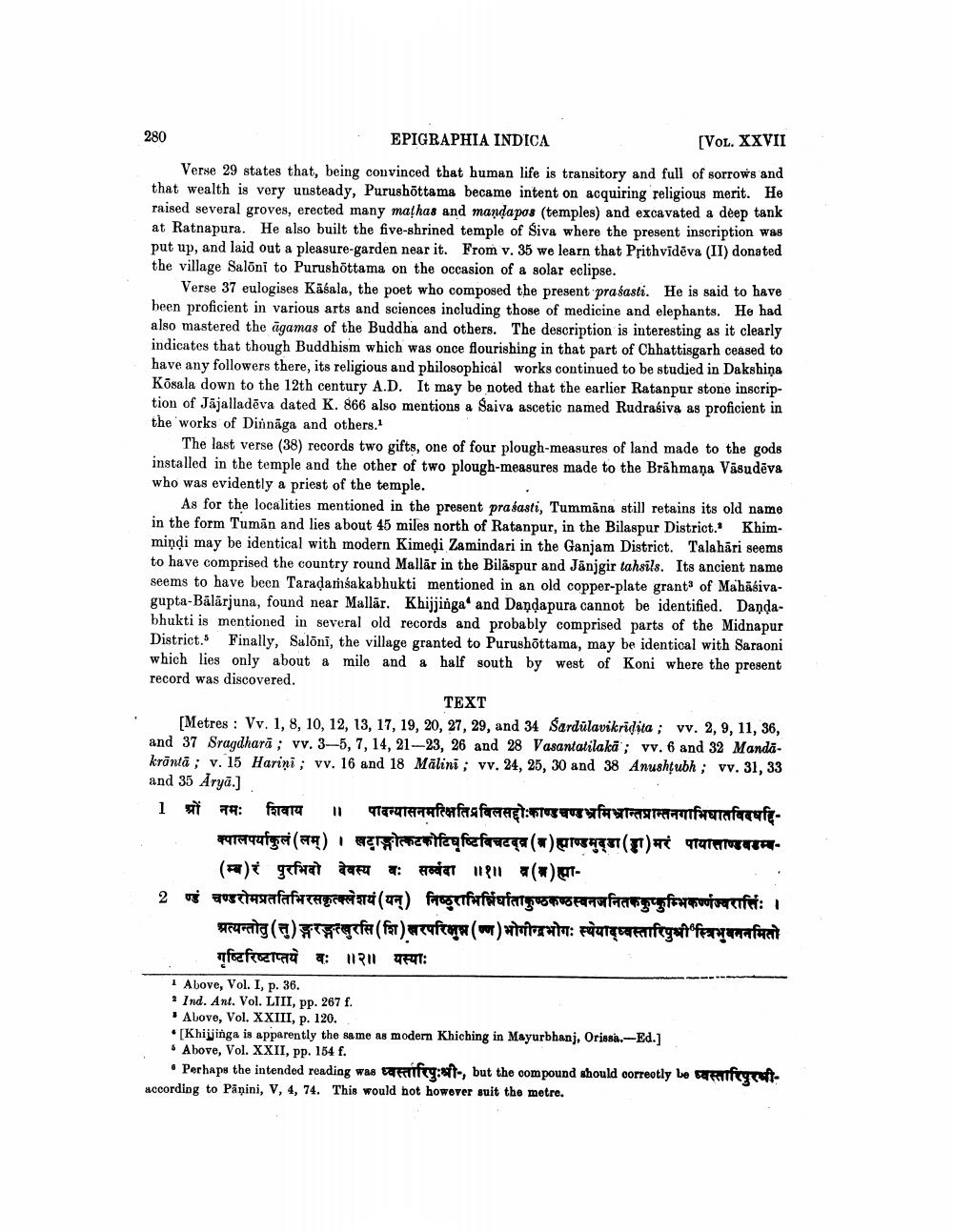________________
280
EPIGRAPHIA INDICA
[VOL. XXVII
Verse 29 states that, being convinced that human life is transitory and full of sorrows and that wealth is very unsteady, Purushottama became intent on acquiring religious merit. He raised several groves, erected many mathas and mandapas (temples) and excavated a deep tank at Ratnapura. He also built the five-shrined temple of Siva where the present inscription was put up, and laid out a pleasure-garden near it. From v. 35 we learn that Prithvidēva (II) donated the village Saloni to Purushottama on the occasion of a solar eclipse.
Verse 37 eulogises Kasala, the poet who composed the present prasasti. He is said to have been proficient in various arts and sciences including those of medicine and elephants. He had also mastered the agamas of the Buddha and others. The description is interesting as it clearly indicates that though Buddhism which was once flourishing in that part of Chhattisgarh ceased to have any followers there, its religious and philosophical works continued to be studied in Dakshina Kōsala down to the 12th century A.D. It may be noted that the earlier Ratanpur stone inscription of Jajalladēva dated K. 866 also mentions a Saiva ascetic named Rudrasiva as proficient in the works of Dinnaga and others.1
The last verse (38) records two gifts, one of four plough-measures of land made to the gods installed in the temple and the other of two plough-measures made to the Brahmaņa Vasudeva who was evidently a priest of the temple.
As for the localities mentioned in the present prasasti, Tummana still retains its old name in the form Tuman and lies about 45 miles north of Ratanpur, in the Bilaspur District. Khimmindi may be identical with modern Kimedi Zamindari in the Ganjam District. Talahari seems to have comprised the country round Mallar in the Bilaspur and Janjgir tahsils. Its ancient name seems to have been Taraḍamšakabhukti mentioned in an old copper-plate grants of Mahasivagupta-Bälärjuna, found near Mallar. Khijjinga and Dandapura cannot be identified. Dandabhukti is mentioned in several old records and probably comprised parts of the Midnapur District. Finally, Saloni, the village granted to Purushottama, may be identical with Saraoni which lies only about a mile and a half south by west of Koni where the present record was discovered.
TEXT
[Metres Vv. 1, 8, 10, 12, 13, 17, 19, 20, 27, 29, and 34 Sardulavikridita; vv. 2, 9, 11, 36, and 37 Sragdhara; vv. 3-5, 7, 14, 21-23, 26 and 28 Vasantatilaka; vv. 6 and 32 Mandakräntä; v. 15 Harini; vv. 16 and 18 Malini; vv. 24, 25, 30 and 38 Anushṭubh; vv. 31, 33 and 35 Argd.]
1 श्रों नमः शिवाय 11 पादन्यासनमस्थिति विलसद्दोः काण्ड चण्ड भ्रमिभ्रान्तप्रान्तनाभिघातविवहिक्पालपर्याकुलं (लम् ) । खट्ाङ्गोत्कटकोटिषृष्टिविचट (ब्र) ह्याण्डमुडा (ड्डा ) मरं पायालाण्डवडम्ब (ब) रं पुरभिदो देवस्य वः सर्व्वदा ॥१॥ व्र ( ब्र) ह्मा
2 ण्डं चण्डरोमप्रततिभिरसकृत्क्लेशयं ( यन् ) निष्ठुराभिनिर्घाता कुण्ठकण्ठ स्वनजनितक कुम्कुम्भिकर्णज्वरार्त्तिः ।
श्रत्यन्तोतु (तु) ङ्गरङ्गत्खुरसि (शि) खरपरिक्षुन्न (ष्ण ) भोगीन्द्रभोगः स्थेयाद्ध्वस्तारिपुवी 'स्त्रिभुवननमितो गृष्टिरिष्टाप्तये वः ॥ २॥ यस्याः
1 Above, Vol. I, p. 36.
2 Ind. Ant. Vol. LIII, pp. 267 f.
Above, Vol. XXIII, p. 120.
[Khijjinga is apparently the same as modern Khiching in Mayurbhanj, Orissa.-Ed.]
Above, Vol. XXII, pp. 154 f.
• Perhaps the intended reading was ध्वस्तरिपुः श्री-, but the compound should correctly bo ध्वस्तारिपुरभीaccording to Panini, V, 4, 74. This would hot however suit the metre.




